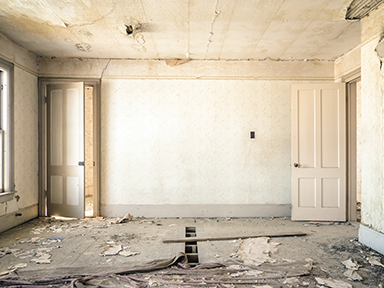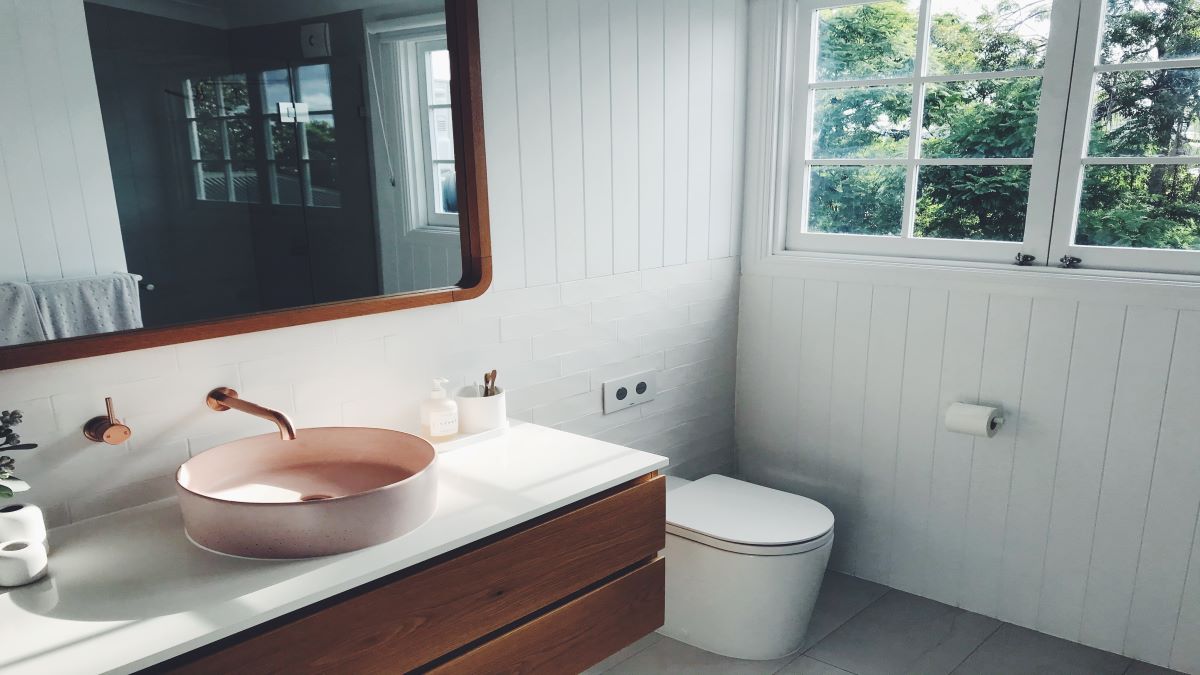Fungi may be small, but they can cause big problems. And as damage caused by mould is not covered by landlord insurance, it’s best to nip it in the spore before it spreads.
It starts with one little fun-guy setting up home in your rental. Then, before you know it, it’s party central for the black spores and you’ve got a horrible fungus spreading, well, like mushrooms.
Moisture, heat, dark and a lack of air flow are BFFs of mould and mildew. In the tropics, where it’s humid year-round, mould is a perennial problem. But it’s also a problem in southern parts of Australia during the summer months when heat, humidity and the storm season arrive, bringing ideal growing conditions. With this summer forecast to be a wet one across much of the nation, you may find your rental receives some unwanted guests.
So just what is mould?
Good question. Mould and mildew are living organisms known as fungi. Mould is present virtually everywhere, indoors and outdoors, and can grow in and on materials such as food, furniture, fabrics, carpets, walls, paper, timber and even plumbing. It grows best in damp, poorly ventilated areas with limited or no sunlight, and reproduces by making spores.
As mould thrives on moisture, it’s often found in bathrooms, kitchens, cluttered storage areas, wall and roof spaces, under carpets, in ventilation/air-conditioner ducts or behind furniture. Mould can spread from one surface to another by contact or it can be air-borne.
It’s harmless, right?
Wrong. While mould on your fancy cheese is a good thing, mould in your rental property definitely is not. More than being unsightly, mould can cause serious problems – both for occupants and for the building itself.
You see, when mould dries out or is disturbed, it releases spores which can cause illness in some people or exacerbate existing health issues like asthma, respiratory infections, sinus problems, skin irritations or itchy eyes.
But it’s more than just an irritant. Mould can also cause odours and damage to building materials, contents and structures. If left untreated, it can spread into plaster, ceiling cavities, behind walls, in and behind gyprock and under carpets and floorboards – potentially causing structural damage. This can lead to expensive maintenance, replacement or management costs such as professional cleaning.
NOTE: If mould gets to the point where it’s posing risks and the rental becomes uninhabitable, it can be grounds to terminate the lease agreement.
Don’t like the sound of that? Then best know how to identify it.
Sniff, sniff. With its musty odour, it’s often obvious that mould and mildew are present. It’s a stale and damp scent that lingers in the air and some varieties, like black mould, can also smell earthy. It also doesn’t try to disguise itself – it presents as green, grey, white, brown or black spots and clusters. You can usually spot the most visible type of mould, called mildew, which begins as tiny, usually black spots, but often grows into larger colonies. It’s the black stuff you see in the grout lines in your shower, on damp walls, and outdoors on the surfaces of decking boards and painted siding, especially in damp and shady areas.
Found mould? You might be wondering who needs to sort it out.
If mould takes up residence, you want to get rid of it as soon as possible. But just who is responsible for dealing with the fungi?
The answer depends on why the mould has developed in the first place.
The cause of mould/mildew in your rental could stem from maintenance issues or from the action or inaction of tenants. Which means fixing the problem could rest with either you or with your tenants.
When is a landlord responsible?
As a landlord you are required to keep the property in a reasonable state of repair, meet building, health and safety requirements, and ensure all repairs are undertaken within a reasonable timeframe. If you don’t want to risk breaching the tenancy agreement, make sure you keep on top of maintenance and repairs.
So when it comes to responsibility for mould, it’s yours if the outbreak is caused by structural issues, or stems from a lack of maintenance or repair such as:
- a leak in the roof
- a faulty pipe
- malfunctioning gutters causing overflow into the property
- surface water leaking into the building
- wet building foundations such as rising damp
- indoor plumbing leaks, or
- unrepaired exhaust fans or wall-mounted heating/cooling units.
Your tenant may be able to seek compensation from you if mould damages their personal property and you have failed to take reasonable steps. It’s important for tenants to understand their obligation to mitigate any losses too, for example a tenant should remove clothes from a wardrobe where there is mould growing.
You or your agent should keep an eye out for potential repair or structural problems during inspections and encourage tenants to immediately report any dampness, windows that don’t close properly or leaks – and act quickly to fix the problems.
When is a tenant responsible?
Tenants are responsible for keeping the rental property in a reasonable state of cleanliness, not intentionally or negligently causing or permitting damage, and informing landlord or agent of any damage as soon as possible. If the tenant has caused the underlying problem that led to mould developing or hasn’t informed you or your agent of an issue with the property, they could be held responsible for mould damage and may have to compensate you.
Your tenant could be responsible for cleaning up outbreaks if their actions resulted in mould forming. For example:
- by showering without switching on the exhaust fan or opening a window
- leaving pools of water on tiles
- cooking without turning on the extractor fan
- using a drier without ventilation or drying clothes indoors and not airing the room afterwards
- failing to properly clean up indoor liquid spills
- getting the carpet wet and neglecting to properly dry it out
- neglecting to wipe condensation from walls or windows
- storing large volumes of water-absorbent materials such as books or cardboard boxes in a damp space
- not cleaning the home properly, or
- leaving windows or doors open during rain.
If you or your agent spot a mould problem caused by your tenant’s actions, be sure to let them know. If the issue is something you can help with, such as installing exhaust fans, then look to do this – it is a good way to safeguard your property.
And we get rid of mould how?
Mould is unlikely to die out on its own – it needs to be cleaned away.
If the mould is widespread (over one square metre) or identified within structures, you’ll need to get a specialist cleaner in to sort out the problem.
You or your tenant should only attempt to clean up minor outbreaks of surface mould, for example if it’s in a cupboard or wardrobe or a small patch on a wall or on bathroom tiles.
If you want to try to remove the mould without calling in the experts, visit the Health Department website, as most states have guidelines available.
NOTE: Don’t breach your duty of care (and risk being liable for injury or losses) and ask tenants to undertake any cleaning that could pose health or safety risks, for example that requires the use of a ladder or harsh chemicals (such as bleach). This cleaning should be contracted out to professionals who are licensed/certified and insured.
Can the clean-up costs be claimed on insurance?
In a word… no. Damage caused by mould/mildew/fungus/algae is a standard exclusion in most building and contents policies in Australia. This means that if there is an outbreak at the rental, neither landlord nor tenant is likely to be able to claim on their insurance for any damage.
Why? Because mould growth is frequently unavoidable and it usually doesn’t cause damage if it’s taken care of quickly. Insurance is designed to cover unexpected events, not compensate for neglect or the inevitable. Although, you should check with your insurer if the mould damage is the direct result of an insured event, such as a storm or flood, to see if it’s covered by the policy.
So, if you’re responsible for the mould at your rental, you’re responsible for the cost of cleaning, repair or replacement. Ditto, if your tenant is responsible.
The best way for you and your tenants to avoid having to deal with the dreaded fungi is to keep on top of maintenance, repairs, cleaning and ventilation, as the way to control mould growth is to control the source of moisture.
*While we have taken care to ensure the information above is true and correct at the time of publication, changes in circumstances and legislation after the displayed date may impact the accuracy of this article. If you need us we are here, contact 1800 661 662 if you have any questions.
You may also like
View all
If you own or manage an investment property in a strata complex, it is important to understand who is responsible for insuring what...

Damage is damage, right? Well, not when it comes to insurance...



